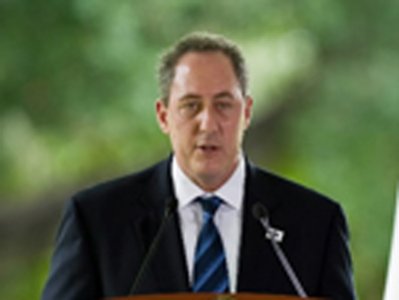Negotiations on a U.S.-EU Transatlantic Trade and Investment Partnership could begin by the end of June based on comments by White House Deputy National Security Adviser Michael Froman to an informal meeting of EU trade ministers last week. The EU was the world’s largest importer of agricultural commodities and food in 2012 ã« $131 åå„„, アップ 145 以来パーセント 2000. ç±³. agricultural exports to the EU of $10.1 億㧠2012 increased only 54 percent over that same time.
アメリカ. share of the EU market in 2012 ã¾ã—㟠7 パーセント, half the share in 2000 according to a Foreign Agricultural Service report Agricultural Exports to the European Union: Opportunities and Challenges. The EU was once the largest market for the U.S., but is now the fifth largest behind China, カナダ, Mexico and Japan. ç±³. ã®è¼¸å‡º $10.1 billion to the EU-27 countries in 2012 were less than the $13 billion of exports in 1980 to those 27 国. When adjusted for the price level change, に輸出する 1980 ã¾ã—㟠$36 億㧠2012 ドル.
Brazil has taken over as the top supplier to the EU with a market share estimated to be almost double the U.S. share. Soybean and soybean meal shipments are a major factor in that shift. China and Chile have also increased market share in the EU, with fruit and vegetable exports as prominent products. Ukraine has grown to be a $5 billion supplier in 2012 of grain, 菜種, and sunflower oil.
ã« 1980, corn and soybeans together accounted for 48 米国ã®ãƒ‘ーセント. exports to the EU; ã« 2012 they were 15 パーセント. Biotechnology has become the biggest barrier to trade. Ukraine is the largest supplier of corn and Brazil for soybeans. Some high-value, consumer-oriented products have gained in value. Exports of tree nuts have increased from $381 万人㧠1980 to more than $1.7 億㧠2012. Consumer-oriented products like beef and poultry continue to face significant sanitary and phyto-sanitary (SPS) issues and technical barriers to trade (TBT).
Bioenergy has been a bright spot over the last five years. Ethanol exports to the EU were $450 万人㧠2012, 37 percent of EU ethanol imports, and wood pellets and wood chips were valued at $250 百万. Biodiesel exports were down because of EU antidumping and countervailing duties imposed in 2009. A 9.6 percent anti-dumping duty has been placed on U.S. ethanol imports. The EU Renewable Energy Directive requires biofuels to meet certain sustainability criteria to qualify for tax incentives and count toward use mandates and will likely affect imports of energy feed stocks and renewable fuels from the U.S.
In contrast to the decline in U.S. exports to the EU, ç±³. agricultural imports from the EU reached a record $16.7 億㧠2012, アップ 4 ã‹ã‚‰ã®ãƒ‘ーセント 2011. Top products included wine and beer, essential oils, and snack foods. アメリカ. agricultural trade deficit of $6.7 億㧠2012 for the EU was the largest of any U.S. trading partner and contrasts sharply with that of other countries.
The April 9 issue of Amber Waves from the Economic Research Service of USDA delved deeper into the potential for horticultural exports to the EU in Free-Trade Agreements: New Trade Opportunities for Horticulture. The EU-27 has a combined population of 503 million people and GDP of $17.6 å…†, both larger than the U.S. ã«ã¨ã£ã¦ 2009-11 annual horticultural exports from the U.S. to the EU averaged $2.3 billion across 143 different products. The EU has numerous tariff rate quotas (TRQ) and for many fresh products it applies variable tariffs based on the time of the year when imports compete with local supplies. Processed products have tariffs based on container size, sugar content and import price.
Five products – shelled almonds, unshelled pistachios, raisins, and shelled and unshelled walnuts – in 2009-11 accounted for about two-thirds of total U.S. horticultural exports to the EU. Only almonds are subject to a TRQ, although the over-quota tariff is small at 3.5 パーセント. Shelled walnuts have the highest tariff at 5.1 パーセント. ç±³. exports would be expected to increase for all five if the EU lowered or eliminated tariffs and quotas.
Other products with minimum tariffs of 10 percent or greater and high export potential include prepared/preserved tomatoes, certain fruit juices, dried onions, grapefruit juice, and sweet corn. Products subject to TRQs with over-quota tariff rates in excess of 20 percent and quota fill rates equal to or near 100 percent include fresh grapes, ã•ãらんã¼, and apples and fresh orange juice. Strong export gains are also expected for prunes, berries, ã¨ã‚¤ãƒã‚´.
Bilateral and regional free trade agreements often establish SPS and TBT committees under the WTO Agreements on the Application of Sanitary and Phytosanitary Measures and Technical Barriers to Trade to facilitate consultation and resolve contentious issues. The ongoing Trans-Pacific Partnership Free Trade Agreement negotiations among the U.S. ãã—㦠11 国, now also Japan, have included talks on an enforceable WTO-plus SPS agreement to push beyond the WTO agreement. That would also be essential for the Transatlantic Trade and Investment Partnership.
The EU-27 countries as a group is the kind of high income, diversified market that U.S. agricultural producers dream about. あのアメリカ. exports have declined as much as they have is partly the fault of years of disagreements on trade issues when both sides believed that trade was a one way street and they could afford to disagree and look for markets elsewhere. Both have been losers as exporters and importers.
Talks on the Transatlantic Trade and Investment Partnership provide an opportunity for each side to have a fresh start on agricultural issues. Exports and imports are extensions of multinational supply chains that smooth out supply imbalances to the benefit of both producers and consumers. For horticultural products the reduction of tariffs and quotas will be a central focus. For all products, the SPS and TBT issues that have vexed trade relations for the past 20 years will be critical to an acceptable outcome. The negotiations will be complex, but an agreement will be valuable to both sides.
ãƒã‚¹Korvesã¯å±•è¦§ä¼šã«ã¤ã„ã¦ã®çœŸå®Ÿã¨ã®è²¿æ˜“や経済政ç–アナリストã§ã‚ã‚Šã¾ã™ & 技術 (www.truthabouttrade.org). フォãƒãƒ¼ã™ã‚‹: Twitterã§@TruthAboutTrade | 展覧会ã«ã¤ã„ã¦ã®çœŸå®Ÿ & Facebook上ã§ã®æŠ€è¡“.

